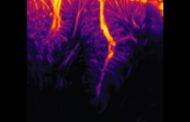
Diagrams of neural activity in the hippocampus, recorded from a mouse as it learned about new surroundings. Colors correspond to unique locations within the new place. Over time and continued exposure to the arena, the mouse forms stable memories by recruiting teams of neurons to encode for the location. Credit: Caltech
Strong memories are encoded by teams of neurons working together in synchrony
Why is it that you can remember the name of your childhood best friend that you haven’t seen in years yet easily forget the name of a person you just met a moment ago? In other words, why are some memories stable over decades, while others fade within minutes?
Using mouse models, Caltech researchers have now determined that strong, stable memories are encoded by “teams” of neurons all firing in synchrony, providing redundancy that enables these memories to persist over time. The research has implications for understanding how memory might be affected after brain damage, such as by strokes or Alzheimer’s disease.
The work was done in the laboratory of Carlos Lois, research professor of biology, and is described in a paper that appears in the August 23 of the journal Science. Lois is also an affiliated faculty member of the Tianqiao and Chrissy Chen Institute for Neuroscience at Caltech.
Led by postdoctoral scholar Walter Gonzalez, the team developed a test to examine mice’s neural activity as they learn about and remember a new place. In the test, a mouse was placed in a straight enclosure, about 5 feet long with white walls. Unique symbols marked different locations along the walls—for example, a bold plus sign near the right-most end and an angled slash near the center. Sugar water (a treat for mice) was placed at either end of the track. While the mouse explored, the researchers measured the activity of specific neurons in the mouse hippocampus (the region of the brain where new memories are formed) that are known to encode for places.
When an animal was initially placed in the track, it was unsure of what to do and wandered left and right until it came across the sugar water. In these cases, single neurons were activated when the mouse took notice of a symbol on the wall. But over multiple experiences with the track, the mouse became familiar with it and remembered the locations of the sugar. As the mouse became more familiar, more and more neurons were activated in synchrony by seeing each symbol on the wall. Essentially, the mouse was recognizing where it was with respect to each unique symbol.
To study how memories fade over time, the researchers then withheld the mice from the track for up to 20 days. Upon returning to the track after this break, mice that had formed strong memories encoded by higher numbers of neurons remembered the task quickly. Even though some neurons showed different activity, the mouse’s memory of the track was clearly identifiable when analyzing the activity of large groups of neurons. In other words, using groups of neurons enables the brain to have redundancy and still recall memories even if some of the original neurons fall silent or are damaged.
Gonzalez explains: “Imagine you have a long and complicated story to tell. In order to preserve the story, you could tell it to five of your friends and then occasionally get together with all of them to re-tell the story and help each other fill in any gaps that an individual had forgotten. Additionally, each time you re-tell the story, you could bring new friends to learn and therefore help preserve it and strengthen the memory. In an analogous way, your own neurons help each other out to encode memories that will persist over time.”
Memory is so fundamental to human behavior that any impairment to memory can severely impact our daily life. Memory loss that occurs as part of normal aging can be a significant handicap for senior citizens. Moreover, memory loss caused by several diseases, most notably Alzheimer’s, has devastating consequences that can interfere with the most basic routines including recognizing relatives or remembering the way back home. This work suggests that memories might fade more rapidly as we age because a memory is encoded by fewer neurons, and if any of these neurons fail, the memory is lost. The study suggests that one day, designing treatments that could boost the recruitment of a higher number of neurons to encode a memory could help prevent memory loss.
“For years, people have known that the more you practice an action, the better chance that you will remember it later,” says Lois. “We now think that this is likely, because the more you practice an action, the higher the number of neurons that are encoding the action. The conventional theories about memory storage postulate that making a memory more stable requires the strengthening of the connections to an individual neuron. Our results suggest that increasing the number of neurons that encode the same memory enables the memory to persist for longer.”
Learn more: How Memories Form and Fade
The Latest on: Human memory storage
[google_news title=”” keyword=”human memory storage” num_posts=”10″ blurb_length=”0″ show_thumb=”left”]
via Google News
The Latest on: Human memory storage
- The unspoken obnoxiousness of Google’s Gemini improvementson April 26, 2024 at 2:45 am
Google's Gemini chatbot is seeing all sorts of upgrades on Android this week, but those advancements reveal a darker underlying reality.
- How do specialized regions develop in the brain?on April 25, 2024 at 4:47 pm
The human brain is an incredibly complex organ composed of various specialized regions, each responsible for different functions.
- Researchers develop deep learning alternative to monitoring laser powder bed fusionon April 24, 2024 at 9:12 am
Many things can go wrong when additively manufacturing (AM) metal and without in-situ process monitoring, defects can only be detected and characterized after a product is built. Most commonly, ...
- How can we harness sleep to enhance our memory?on April 24, 2024 at 9:01 am
How does memory consolidation work, and can we improve our memory retention as we sleep? If so, how? In this Special Feature, we look at what studies have found out about sleep techniques and memory ...
- Bluehost vs. GoDaddy: Which is best in 2024?on April 24, 2024 at 3:14 am
In terms of storage, GoDaddy slightly edges out Bluehost by offering 25GB SSD storage on its lowest-tier plan, Economy. GoDaddy’s Deluxe plan provides 50GB of storage, the Ultimate plan allots 75GB ...
- NASA's Voyager 1 spacecraft finally phones home after 5 months of no contacton April 22, 2024 at 10:33 am
Thirty-five years after its launch in 1977, Voyager 1 became the first human-made object to leave the solar system and enter interstellar space. It was followed out of our cosmic quarters by its space ...
- Reimagining Memory: New Research Reveals That Superconducting Loops Mimic the Brainon April 19, 2024 at 6:10 am
Superconducting loops could allow computers to retain and retrieve information more efficiently. Computers work in digits — 0s and 1s to be exact. Their calculations are digital; their processes are ...
- How Brain Cells Coordinate Storage of Short-Term Memoryon April 18, 2024 at 1:41 am
Cedars-Sinai investigators have discovered how brain cells responsible for working memory–the type required to remember a phone number long enough to dial it–coordinate intentional focus and ...
- Workings of working memory detailedon April 17, 2024 at 11:42 am
Investigators have discovered how brain cells responsible for working memory -- the type required to remember a phone number long enough to dial it -- coordinate intentional focus and short-term ...
- The best deals at Amazon will save you a bundle on tech, mattresses and moreon April 16, 2024 at 3:54 pm
Whether you're a whiz in the kitchen or a beginner, you've still got to eat. Stop spending so much money on takeout and grab yourself an Instant Pot Pro Plus. You'll feel much better and save money -- ...
via Bing News







